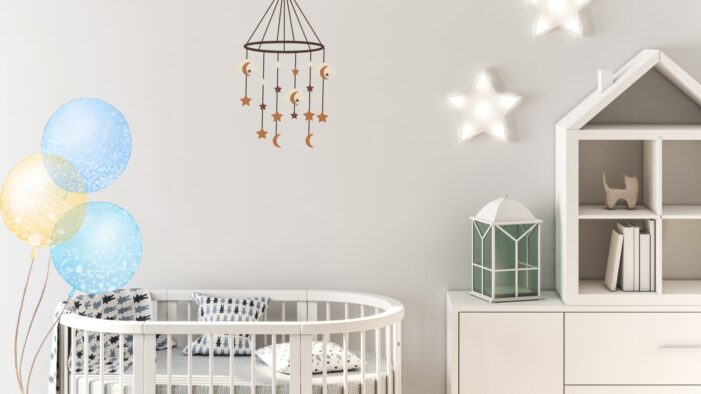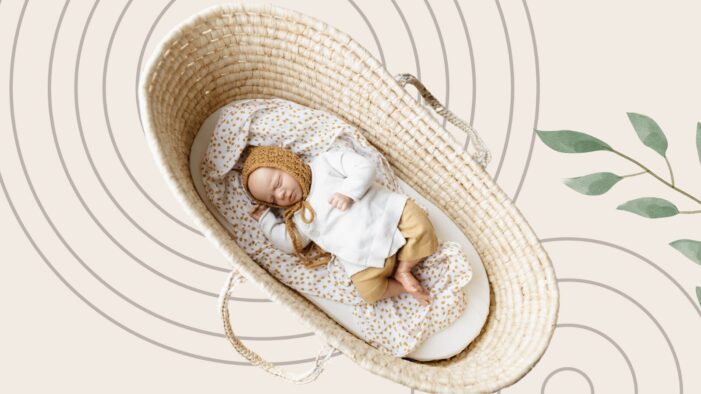Choosing the right sleeping arrangement for your newborn is crucial for their safety, comfort, and your convenience.
With so many options available on the market, deciding the right one can be a challenge.
That’s why I want to provide you with some guidance, by pointing out the major differences between bassinets and cribs.
Without further ado, let us begin.
Key Differences

A bassinet is a small, portable bed designed for newborns, typically used from birth to about 6 months.
Bassinets are known for their cozy, enclosed space which mimics the womb, providing a sense of security for newborns.
They often feature mesh sides for breathability, and a lightweight frame for easy mobility, and some models include additional features like:
- Rocking mechanisms
- Soothing sounds
- Storage compartments
There are various types of bassinets to consider:
- Co-sleeper Bassinets:
- These allow parents to have their baby close by, often attaching to the side of the parent’s bed for easy access during the night.
- Travel Bassinets:
- These are designed for portability, often lightweight and easy to fold, making them ideal for families on the go.
- Smart Bassinets:
- These come equipped with high-tech features like automated rocking, white noise, and even sleep tracking to help soothe the baby back to sleep.
A crib is a larger, sturdier sleeping arrangement that can be used from infancy through toddlerhood.
Cribs offer a spacious sleeping area that accommodates a baby’s growth and provides a stable environment for safe sleep.
They come in various styles, each catering to different needs and preferences:
- Traditional Cribs:
- The standard crib design, providing a secure and comfortable space for the baby.
- Mini Cribs:
- Smaller than traditional cribs, ideal for limited spaces or as a secondary crib.
- Convertible Cribs:
- These cribs can transform into toddler beds, daybeds, or even full-sized beds, offering long-term usability.
- Round Cribs:
- Unique design, offering a different aesthetic and sometimes more space for the baby to move around.
Safety Guidelines for Both

Ensuring your baby’s sleeping environment is safe is paramount.
The American Academy of Pediatrics (AAP) recommends several guidelines for safe sleep, applicable to both bassinets and cribs.
Key recommendations include placing babies on their backs to sleep, keeping the sleep area free of loose items like blankets and toys, and room sharing without bed sharing for the first six months.
Bassinet
When using a bassinet, adhere to the weight limits specified by the manufacturer and avoid using the bassinet once the baby starts pushing up on hands and knees.
Opt for bassinets with a flat, firm sleep surface and mesh sides for breathability.
Ensure any wheels have locks to prevent accidental movement.
Crib

For cribs, it’s essential to choose one with a sturdy construction and no wide gaps between slats to prevent the baby’s head from getting stuck.
The mattress should fit snugly within the crib frame to avoid suffocation hazards, and there should be no tall corner posts that could catch the baby’s clothing.
Regularly check the crib for any loose or broken parts.
Comfort and Convenience
Bassinets offer a smaller, cozier space for newborns, which can be comforting in the early stages of life.
Their compact size makes them ideal for room sharing, allowing parents to keep the baby close during the night for feeding and comforting.
The mobility of bassinets is another significant advantage; they can be easily moved from room to room, ensuring the baby is always nearby.
Additional features like rocking, soothing sounds, and built-in storage further enhance the convenience of bassinets.
Cribs provide a larger sleeping area, accommodating the baby’s growth from infancy to toddlerhood.
Many cribs come with adjustable mattress heights, allowing you to lower the mattress as the baby grows and starts to stand.
Convertible cribs offer long-term use, transforming into toddler beds, daybeds, and even full-sized beds, providing a lasting investment.
While less portable than bassinets, cribs form the centerpiece of the nursery, offering stability and safety for older infants and toddlers.
Practical Considerations

There are some practical considerations you need to take a look at.
Size and Space
Bassinets are ideal for small spaces and parents who prioritize portability. They fit easily beside the parents’ bed and can be moved throughout the home.
Cribs, on the other hand, are better suited for long-term use and become a permanent fixture in the nursery.
While they require more space, their stability and longevity make them a practical choice for the baby’s primary sleeping arrangement.
Multifunctionality and Features
Bassinets often come with soothing mechanisms such as rocking or vibrating functions, as well as built-in storage for diapers and baby essentials.
Cribs, particularly convertible models, offer versatility by transforming into different types of beds as the child grows, making them a cost-effective long-term solution.
Design and Aesthetic Appeal
Bassinets come in various styles, from modern to traditional, allowing parents to choose one that complements their bedroom decor.
Cribs also offer a wide range of designs, typically serving as the focal point of the nursery.
Coordinating the crib with the overall nursery theme can create a cohesive and inviting space for the baby.
Transitioning from Bassinet to Crib
Signs that your baby has outgrown the bassinet include reaching the weight limit, starting to roll over or push up on hands and knees, and appearing cramped in the bassinet.
Typically, this transition occurs around 4–6 months.
To ease the transition from bassinet to crib, start by having the baby take naps in the crib during the day.
Establishing a consistent bedtime routine can also help, as familiar cues signal to the baby that it’s time to sleep.
Initially, staying nearby during sleep times can provide reassurance and comfort during the transition period.
Making the Decision
When deciding between a bassinet and a crib, consider your mobility needs, room-sharing preferences, space availability, and budget.
Bassinets offer portability and convenience for room sharing, making them suitable for the early months.
Cribs provide a long-term solution, with many convertible options offering extended usability.
Balancing these factors based on your family’s lifestyle and needs will guide you in making the best choice for your baby’s sleeping arrangement.

